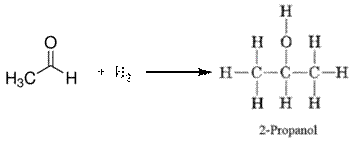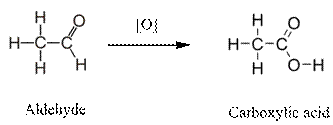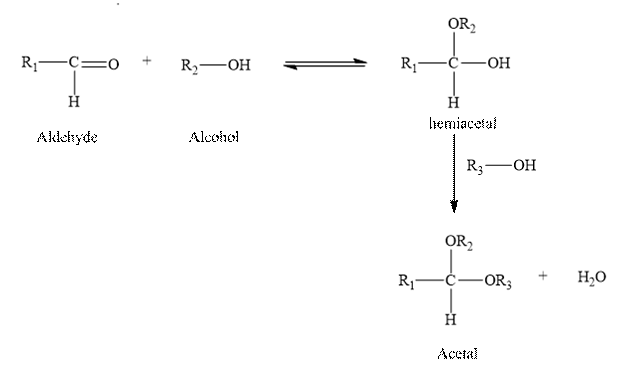
Concept explainers
17-30 Answer true or false.
(a) The reduction of an
(b) The reduction of a
(c) The oxidation of an aldehyde gives a
(d) The oxidation of a primary alcohol gives a ketone.
(e) Tollens’ reagent can be used to distinguish between an aldehyde and a ketone.
(f) Sodium borohydride, NaBH4, reduces an aldehyde to a primary alcohol.
(g) The addition of one molecule of alcohol to the carbonyl group of a ketone gives a hemiacetal.
(h) The reaction of an aldehyde with two molecules of alcohol gives an acetal, plus a molecule
of water.
(j) The formation of hemiacetals and acetals is reversible.
(j) The cyclic hemiacetal formed from 4-hydroxy-pentanal has two stereocenters and can exist as
a mixture of 22 = 4 stereoisomers.
(a)
Interpretation:
Answer true or false for the following statement.
The reduction of an aldehyde always gives an alcohol.
Concept Introduction:
Reduction is the addition of a hydrogen atom to a compound.
Answer to Problem 17.30P
The given statement is true.
Explanation of Solution
In aldehydes, the functional group is
Oxidation of aldehydes forms primary alcohol. For example, reduction of pentanal gives 1-pentanol.

Therefore, the given statement is true.
(b)
Interpretation:
Answer true or false for the following statement.
The reduction of ketones always gives a secondary alcohol.
Concept Introduction:
Aldehydes and ketones contain carbonyl group as a functional group. Reduction is the addition of a hydrogen atom to a compound.
Answer to Problem 17.30P
Therefore, the given statement is true.
Explanation of Solution
Reduction of ketones, hydrogen is added to the carbonyl carbon and gives secondary alcohol.

Therefore, the given statement is true.
(c)
Interpretation:
Answer true or false for the following statement.
The oxidation of aldehydes gives a carboxylic acid.
Concept Introduction:
Aldehydes and ketones contain carbonyl group as a functional group. Oxidation is the process in which oxygen is added to the molecule.
Answer to Problem 17.30P
The given statement is true.
Explanation of Solution
Oxidation of aldehydes, oxygen is added to the carbonyl group and form carboxylic acid.

Therefore, the given statement is true.
(d)
Interpretation:
Answer true or false for the following statement.
The oxidation of primary alcohol gives ketone.
Concept Introduction:
Aldehydes and ketones contain carbonyl group as a functional group. Oxidation is the process in which oxygen is added to the molecule.
Answer to Problem 17.30P
The given statement is false.
Explanation of Solution
Oxidation of primary alcohol first converted into aldehyde and followed by carboxylic acids.

Therefore, the given statement is false.
(e)
Interpretation:
Answer true or false for the following statement.
Tollen’s reagent can be used to distinguish between an aldehyde and a ketone.
Concept Introduction:
Tollen’s reagent is a mild oxidizing agent.
Tollen’s reagent is reacts with the aldehyde group of a compound. The carbonyl group acts as a reducing agent and reduces the silver ion of the Tollen’s regent to silver metal.

Answer to Problem 17.30P
The given statement is true.
Explanation of Solution
Aldehydes undergo oxidation easily, even with mild oxidizing agents and give carboxylic acid.
Ketone does not undergo oxidation with mild oxidizing agent due to selectivity of aldehyde and ketone for oxidation is used to differentiate an aldehyde and a ketone. Therefore, aldehyde and ketones are distinguished by using Tollen’s regent.
Therefore, the given statement is true.
(f)
Interpretation:
Answer true or false for the following statement.
Sodium borohydride,
Concept Introduction:
Aldehydes and ketones contain carbonyl group as a functional group. The aldehydes undergoes a reduction reaction where in the addition of hydrogen occurs at the double bond between the oxygen and the carbon of the carbonyl group present in the aldehyde.
Answer to Problem 17.30P
Therefore, the given statement is true.
Explanation of Solution

(g)
Interpretation:
Answer true or false for the following statement.
The addition of one molecule of alcohol to the carbonyl group of a ketone gives a hemiacetal.
Concept Introduction:
Aldehydes and ketones contain carbonyl group as a functional group. In Hemiacetal, carbon is added to hydroxyl group and alkoxy group.
Answer to Problem 17.30P
The given statement is true.
Explanation of Solution
When a molecule of alcohol is added to a ketone, the hydrogen of the alcohol is added o the oxygen atom of the carbonyl group, while the alkoxy group of the alcohol is added to the carbon of the carbonyl group. Hence ketone forms hemiacetal when the reacts with one molecule of alcohol.

Therefore, the given statement is true.
(h)
Interpretation:
Answer true or false for the following statement.
The reaction of an aldehyde with two molecules of alcohol gives an acetal, plus a molecule of water.
Concept Introduction:
Aldehydes and ketones contain carbonyl group as a functional group. In acetal, carbon is bonded to two alkoxy groups.
Answer to Problem 17.30P
The given statement is true.
Explanation of Solution
Two molecules of an alcohol are added to an aldehyde to form hemiacetal. And it is unstable and it reacts with another molecule of an alcohol in the presence of an acid forms acetal and water.

Therefore, the given statement is true.
(i)
Interpretation:
Answer true or false for the following statement.
The formation of hemiacetals and acetal is reversible.
Concept Introduction:
Aldehydes and ketones contain carbonyl group as a functional group. In Hemiacetal, carbon is added to hydroxyl group and alkoxy group. In acetal, carbon is added to a two alkoxy groups.
Answer to Problem 17.30P
The given statement is true.
Explanation of Solution
By using large excess of alcohol hemiacetals and acetals are reversible by the removal of water molecules. To shift the equilibrium towards the left side by the hydrolysis of the acetal to the aldehyde or ketone and alcohol.
Therefore, the given statement is true.
(j)
Interpretation:
Answer true or false for the following statement.
The cyclic hemiacetal formed from 4-hydroxypentanal has two stereocentres and can exists as a mixture of
Concept Introduction:
A stereocentre is a carbon atom with four different groups bonded to it. The stereocentres of molecule can be calculated by using
n= stereocentre.
Answer to Problem 17.30P
The given statement is true.
Explanation of Solution
The cyclic hemiacetal; obtained from 4-hydroxypentanal has two stereocenters.

4- hydroxypentanal has two stereocenters, therefore it have 4 stereoisomers.
Therefore, the given statement is true.
Want to see more full solutions like this?
Chapter 17 Solutions
Introduction to General, Organic and Biochemistry
- 17-70 What simple chemical test could you use to distinguish between the members of each pair of com pounds? Tell what you would do, what you would expect to observe, and how you would interpret your experimental observation. (a) Benzaldehyde and cyclohexanone (b) Acetaldehyde and acetonearrow_forward17-35 Suppose that you take a bottle of benzaldehyde (a liquid, bp 179°C) from a shelf and find a white solid in the bottom of the bottle. The solid turns litmus red; that is, it is acidic. Yet aldehydes are neutral compounds. How can you explain these observations?arrow_forward17-69 Propanal (bp 49°C) and 1-propanol (bp 97°C) have about the same molecular weight, yet their boiling points differ by almost 50°C. Explain this fact.arrow_forward
- 17-34 Explain why liquid aldehydes are often stored under an atmosphere of nitrogen rather than in air.arrow_forward17-33 What simple chemical test could you use to distinguish between the members of each pair of com pounds? Tell what you would do, what you would expect to observe, and how you would interpret your experimental observation. (a) Pentanal and 2-pentanone (b) 2-Pentanone and 2-pentanolarrow_forward17-60 1-Propanol can be prepared by the reduction of an aldehyde, but it cannot be prepared by the acid catalyzed hydration of an alkene. Explain why it cannot be prepared from an alkene.arrow_forward
- 17-3 1 Draw a structural formula for the principal organic product formed when each compound is treated with K2Cr2O7/H2SO4. If there is no reaction, say so. (a) Butanal (b) Benzaldehyde (c) Cyclohexanone (d) Cyclohexanolarrow_forward17-11 What is the difference in structure between an aromatic aldehyde and an aliphatic aldehyde?arrow_forward16-28 Following is the structural formula of metformin, the hydrochloride salt of which is marketed as the antidiabetic medication Glucophage. Metformin was introduced into clinical practice in the United States in 1995 for the treatment of type 2 diabetes. More than 25 million prescriptions for this drug were written in 2000, making it the most commonly prescribed brand-name diabetes medication in the nation. NH NH H3(\ 3 N N Nh2ch3 h Metformin Complete the Lewis structure for metformin, showing all valence electrons. Which nitrogen is the most likely site of protonation? Draw the structural formula of Glucophage.arrow_forward
- 17-28 Show how acetaldehyde can form hydrogen bonds with water.arrow_forward17-26 Account for the fact that acetone has a higher boiling point (56°C) than ethyl methyl ether (11°C) even though their molecular weights are almost the same.arrow_forward18-28 Arrange these compounds in order of increasing acidity: benzoic acid, benzyl alcohol, phenol.arrow_forward
 Introduction to General, Organic and BiochemistryChemistryISBN:9781285869759Author:Frederick A. Bettelheim, William H. Brown, Mary K. Campbell, Shawn O. Farrell, Omar TorresPublisher:Cengage Learning
Introduction to General, Organic and BiochemistryChemistryISBN:9781285869759Author:Frederick A. Bettelheim, William H. Brown, Mary K. Campbell, Shawn O. Farrell, Omar TorresPublisher:Cengage Learning
